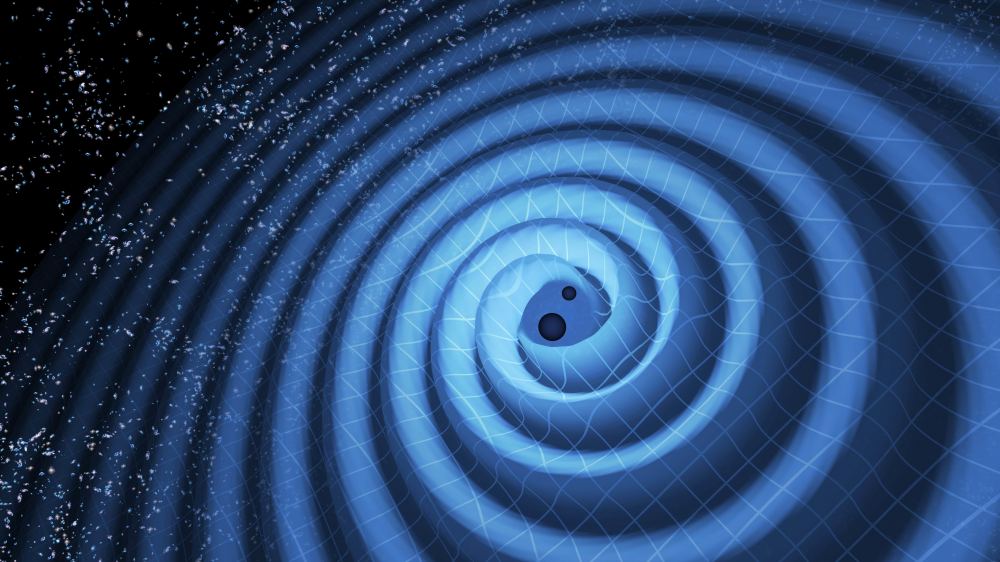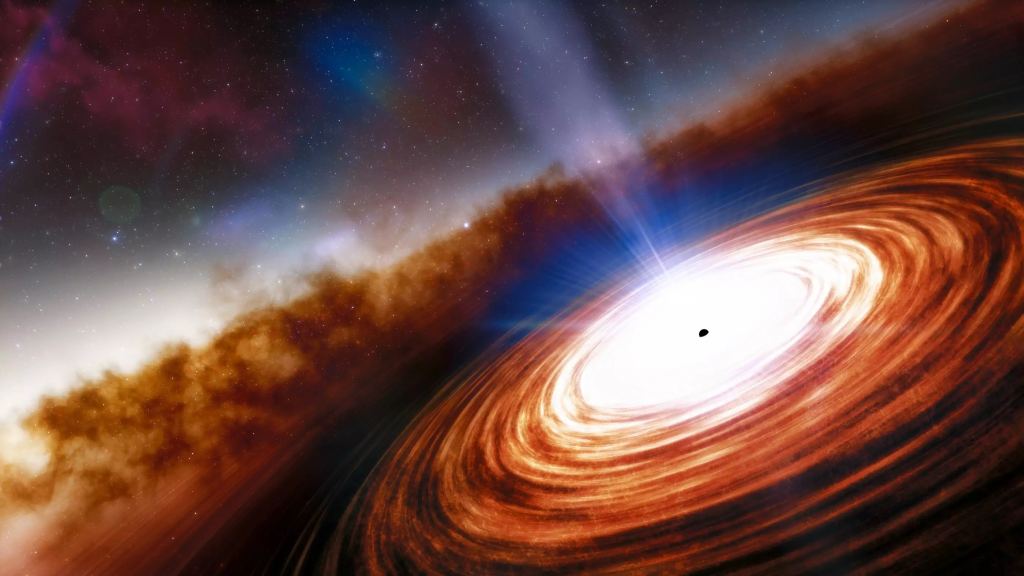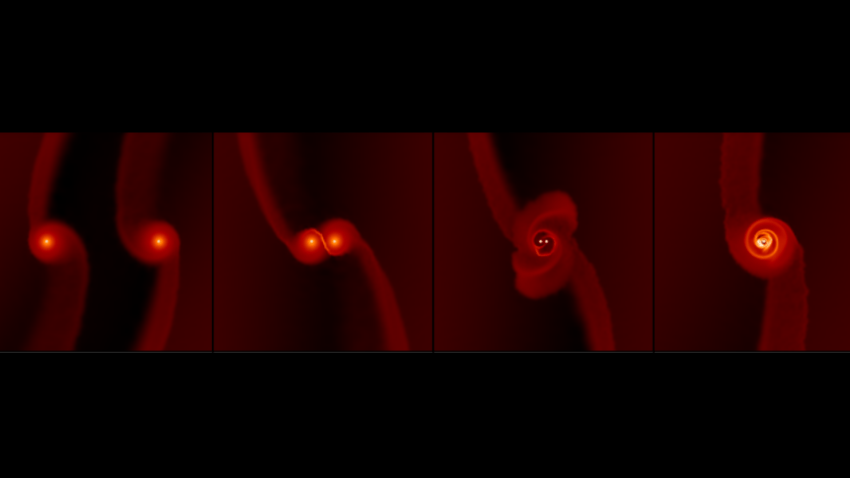This illustration shows the merger of two black holes and the gravitational waves that ripple outward as the black holes spiral toward each other. Could black holes like these (which represent those detected by LIGO on Dec. 26, 2015) collide in the dusty disk around a quasar’s supermassive black hole explain gravitational waves, too? Credit: LIGO/T. Pyle

The universe is awash in gravitational waves. The collisions of massive objects such as black holes and neutron stars generate many of them. Now astronomers are wondering about the environments where these catastrophic events occur. It turns out they might need to look at quasars.
The first gravitational wave detection happened in 2015. Since that time, astronomers have found another 90, and more are sure to be detected. Determining their likely causes and environments is key to understanding the events that cause them. Quasars, with all their activity, seem to be a good place to look. This is particularly true for the kinds of black hole/black hole interactions that can spur gravitational waves.

Artist’s impression of a quasar. These all have supermassive black holes at their hearts. Credit: NOIRLab/NSF/AURA/J. da Silva
A quasar is the heart of an active galactic nucleus. The engine that powers the quasar is a supermassive black hole. Where you have these black hole monsters, you also see dense disks of gas. Those disks swirl around at nearly the speed of light and are quite bright in various wavelengths of light.
It turns out that if a stellar-mass black hole gets dragged into a disk, it could get forced into a binary system with another black hole. Gravitational interactions between them also disturb gas in the surrounding disk. That gas may offer some kind of feedback that affects the orbits of the black holes. Eventually, such feedback could speed up their mergers. That’s the idea behind recent simulations described in a presentation at the meeting of the Royal Astronomical Society. The paper was given by Connar Rowan, a Ph.D. student at the University of Oxford in England.
Simulating Mergers of Black Holes in Quasar Disks
Rowan and a team of astronomers created their computer models to explore the actions at the heart of a quasar. They wanted to explore their possible role in gravitational waves. “These simulations address two main questions: can gas catalyze black hole binary formation and if so, can they ultimately get even closer and merge?” he said. “For this process to explain the origin of the observed gravitational wave signals, both answers need to be yes.”

The key stages of the binary formation mechanism highlighted in the cartoon as snapshots from their moment in the simulations. The first panel shows the “mini”-disks around the isolated black holes before they encounter each other in panels 2 and 3 and become bound to one another. Afterwards, the binary evolves slowly through gravitational interaction with a reformed mini disk, which rotates around both black holes. Credit Connar Rowan et al.
To get to those answers, the team simulated a gas disk with 25 million particles and shaped it as it might exist around the central supermassive black hole in the heart of a quasar. They also inserted two stellar-mass black holes to track their behavior in the disk. They wanted to see if the two objects would get forced into a gravitationally bound binary system. And, what would the forcing mechanisms be? Finally, they wanted to see if the two black holes would eventually merge. It took around 3 months for each simulation to produce an answer.
Bence Kocsis, who heads up the GalNUC consortium that studies these active cores, said that the simulation is a valuable tool. “These results are incredibly exciting as they validate that black hole mergers in supermassive black hole discs can happen,” Kocsis said. “And they possibly explain many or perhaps most of the gravitational wave signals we observe today.”
Stimulating Simulation Results
The results reveal several intriguing possibilities that are stimulating discussion in gravitational wave research circles. First, gas in the disk actually reduces the speed of the black holes during an encounter. They actually stay trapped in orbit around each other even as they orbit the supermassive black hole together. Second, direct gas drag (similar to air resistance) also plays a role. Gas gobbled up by the black holes forces them to decelerate. In response to absorbing the black hole’s kinetic energy via gravitational interaction, the gas is violently ejected immediately following the encounter. This outcome occurs in the majority of the simulations and confirms the previous expectations that gas greatly facilitates the capture of black holes into bound pairs.

Here’s another way to look at the possible black hole mechanism in quasar dust disks. Two isolated black holes orbit a supermassive black hole. They encounter each other inside the large gas disk. The gravitational interaction with gas removes energy from the two black holes, allowing them to stay bound. Courtesy Connar Rowan, et al.
The third finding also showed that the direction of the orbit of the black holes also played a role. In binary systems where the black holes orbit each other opposite to their orbit around the black hole, the black holes got close enough to set off gravitational waves. That basically slowed them down enough to allow a final, catastrophic merger.
The simulations of merging black holes in the vicinity of a quasar provide an intriguing pathway for astronomers searching for additional origins of gravitational waves. “If a sizeable fraction of the observed events, either today or in the future, is caused by this phenomenon, we should be able to see a direct association between quasars and gravitational wave sources in the sky”, said Professor Zoltán Haiman of Columbia University, a member of the team.





